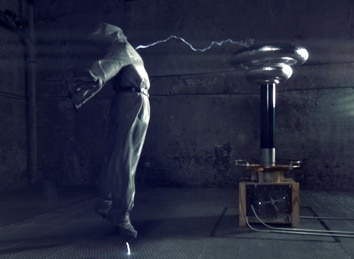Create a free profile to get unlimited access to exclusive videos, sweepstakes, and more!
Cymatics: Science v. Music

I’m about to make you very happy. Stop what you’re doing and watch this extremely cool video called “Cymatics: Science v. Music,” by musician Nigel Stanford. Seriously. Make it high-def, full screen, and crank up the volume.
Science! Music!
There are a couple of things I want to point out in particular. I laughed out loud when I saw the drummer’s spiraling water (starting around the 1:20 mark). His drumming makes the rubber tube vibrate in a circular motion, which sends the water flow out in a different direction over time, like a lawn sprinkler. You don’t see the hose move because the vibration is synched with the video frame rate; every new frame of video is taken when the hose is back to the starting position. I explain this in great detail in an earlier post about this effect (you really do want to see that post; it’s got very cool stuff in it).
I like the way the flames move starting around 3:30, too. There’s a speaker at one end of the gas tube, and as sound waves come out of it the gas in the tube gets compressed and rarefacted (the opposite of compression, so decreasing the density of something) by the waves. Standing waves are created in the gas, like the waves you get if you snap a rope at just the right rate. That’s why you see the flames going up and down in those graceful sine curves.
And I love the patterns of sand on the metal plates seen throughout the video. That’s an interference effect. Waves of sound travel through the plate, making it vibrate. Where the crests of those waves meet each other you get amplification of the waves, again related to standing waves. The patterns are complex because of the shape of the plate; the waves propagate through it and get their direction and shape changed by the edges and corners of the plate. I remember working through the math of this in my grad school mechanics physics class; it took days and many, many sheets of paper to solve the equations even to show how a circular drumhead vibrates, which is a pretty simple shape.
But out of complexity can come great symmetry and beauty. The patterns are lovely.
And Tesla coils? C’mon. They may be the single coolest thing ever invented.
I really like Stanford’s music, too. The video was sent to me by Tom Lowe, an astonishingly talented astrophotographer. Lowe created the time-lapse videos “Rapture,” “TimeScapes,” and “Death Is the Road to Awe,” which are all stunning. Stanford did the music to “TimeScapes,” which is how this is all connected.
I can’t get enough of stuff like this. Astronomy, physics, science, math, music, video … they are all related, and the interconnectivity is, simply, art.


























